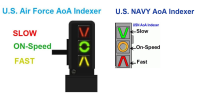@taxi1 yes there's a phugoid and I would show it to my students, but I didn't point out the AoA. Our glide to high key maneuver was 125 knots at zero thrust torque setting, which translates to about 1° nose down. Students would invariably pitch for nose on the horizon or slightly nose up, which of course ruined their dead engine glide with predicable results, so I indirectly taught the phugoid in the context of what was already in the training pub- "power attitude trim," and I noted AoA but in the context of the relationship of max range and minimum sink AoAs (the little triangle and diamond markers on the AoA strip on the PFD; yes those values work a little bit different for maximum range AoA in a propeller airplane vs maximum range AoA in a jet or a glider, but the aero curriculum has been dumbed down to the point of wham bam thank you multiple choice so I didn't want to explode heads any worse).... point being that going any
slower than that 125 knot glide would make the T-6 hit the ground sooner in time and also fall short of the predicted "2nm per 1000 feet" in the training pub,* but going 125 +10/-0 (as the standard is written) would greatly improve your chances of success.
The takeaway from showing that "trimmed in a glide" was to show simply what a phugoid is- the up and down glide that every paper airplane does when you throw it off a great height, and what "trimmed" actually meant (i.e. the airplane actually flies itself pretty well).
The phugoid in that regime was several seconds or longer and about +/- 10 knots... just from what I remember observing.
* funny secret about the T-6B natops and primary contact FTI: "1350-1500fpm at 125KIAS" translates to about 1.7nm per thousand feet, which means even though your math from 10 miles away and 8000' looks perfectly doable, in reality you'll arrive at high key about a thousand feet low. Joke's on you, students and instructors!

